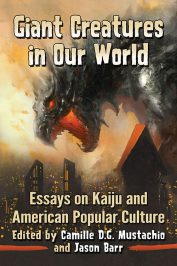Even as today every few years or so new films with giant monsters hit the cinemas, the „kaiju“ (“strange beast/creature”) genre is mostly belittled or ridiculed in academic discussion and film studies as well.
 This situation was not quite satisfying for this book’s editors Mustachio and Barr; considering the fact that the kaiju film has existed since 1933 when King Kong, the very first kaiju or “daikaiju” (“huge strange beast”) was released in the US. (This also makes the kaiju a contemporary of the Mummy and Dracula). So they edited an entire volume with writings (of both academic and fan character) on the monster(s)…
This situation was not quite satisfying for this book’s editors Mustachio and Barr; considering the fact that the kaiju film has existed since 1933 when King Kong, the very first kaiju or “daikaiju” (“huge strange beast”) was released in the US. (This also makes the kaiju a contemporary of the Mummy and Dracula). So they edited an entire volume with writings (of both academic and fan character) on the monster(s)…
Its existence has added massively to popular culture in Asia and the US, the latter culture is dealt with in the major aspects of the book at hand. For the giant monsters – and their presence outside their natural habitats like big cities and scientific research centers – naturally provoke terror, destruction, death and this serves as an intrusion into the safety of (fictional) human life.
Therefore it is essential to understand the two and very different approaches of kaiji film making in the US and Japan. While Hollywood (and Western directors alike) can only invent them as man’s antagonist, as Christian thought only elevates man to rule the land and dominate everything else, in Shinto religion both man and nature represent the divine. Furthermore there are many mysterious characters from folklore and a multitude of gods around. Hence Japanese kaiju can manifest with all sorts of characteristics, they can be villain, heroes, friends, allies or protectors of mankind.
The only possible way to deal with them in American kaiju movies is to reestablish the divine order of things with man killing the beast, while in Japanese films of this kind the kaiju not always ends up dead. So interpreting the kaiju should always take into consideration its special status and ability to change, transform, warn mankind of dangerous developments and to fulfill many different functions that may not straightaway occur to a Western audience. After all, almost all kaiju surfaced only when the world became unbalanced, a new (nuclear) weapon was tested, a new technology proved dangerous or mankind was attacked by another monster, be it from this planet or alien…
Mustachio and Barr have collected a total of eleven essays that deal with detailed analysis of the movies such as Pacific Rim, Gamera III, Monster Zero, Big Man Japan, the various Godzilla films, the Japanese TV shows Kamen Rider and Ultraman, the portrayal of women in these productions, adult monster toy collecting, the kaiju and the (American) superhero, and the philosophy of the monster film in postwar Japan.
All in all, a solid overview on contemporary kaiju research, that introduces religious, social, technical, commercial, philosophical and other aspects of dealing with modern civilization of the movie genre – as there were no “real” kaiju before there were movies that introduced them to the world.
Review by Dr. A. Ebert © 2018
Camille D. G. Mustachio and Jason Barr (eds.) Giant Creatures in Our World: Essays on Kaiju and American Popular Culture, McFarland, 2017, 212 p.
